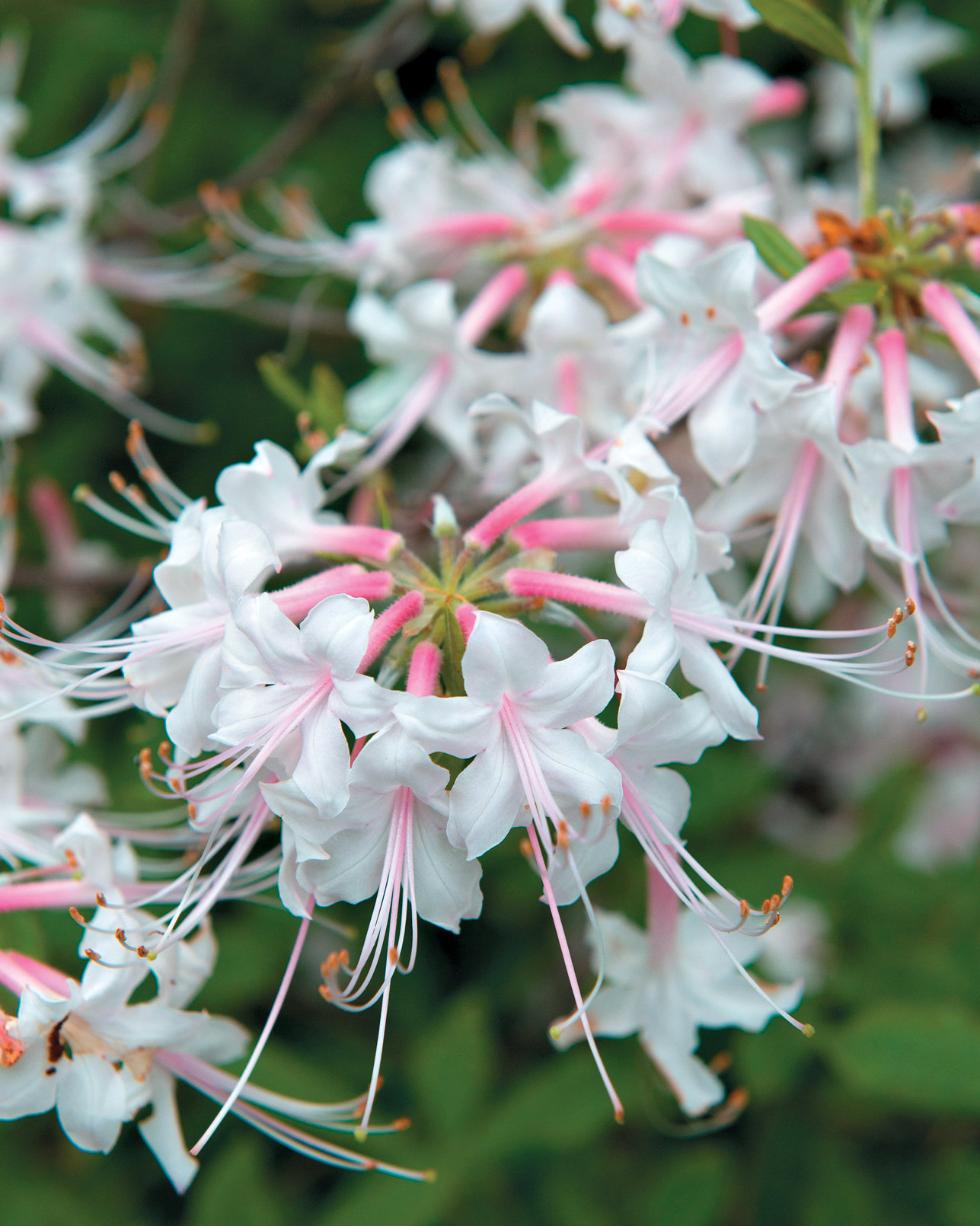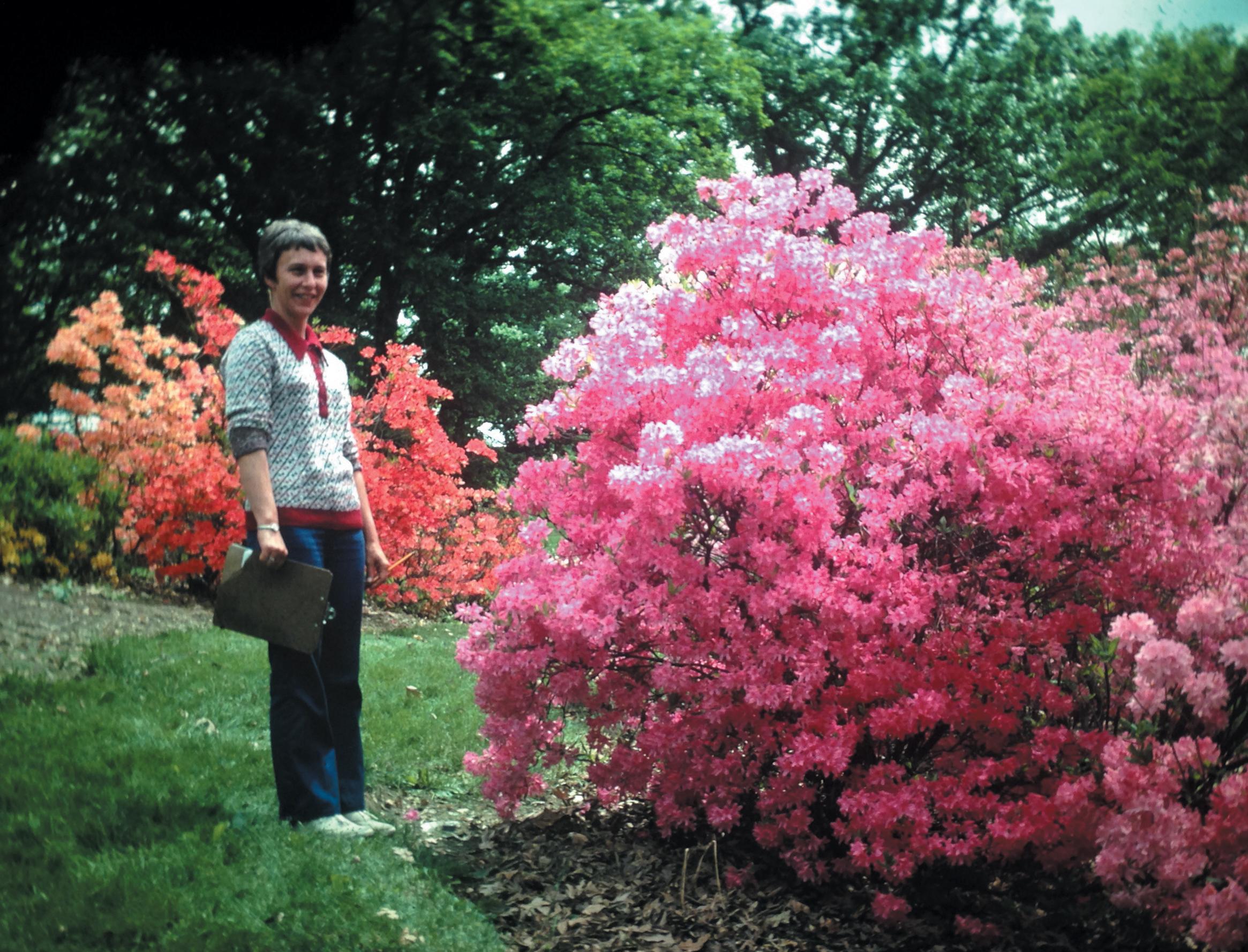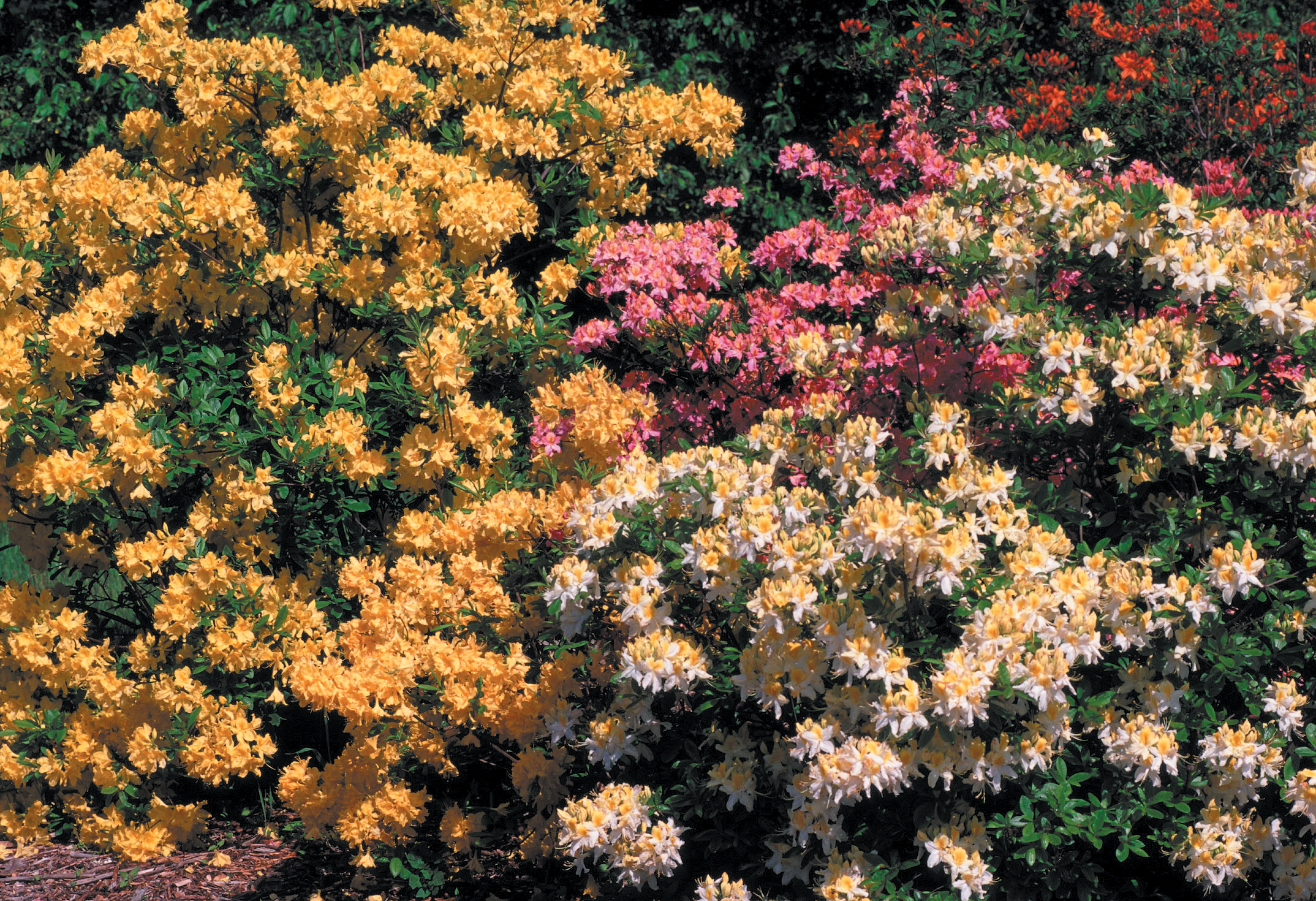North American deciduous azaleas have long been adored by horticulturists. These plants, which belong to the genus Rhododendron sect. [section] Pentanthera, comprise 15 species distributed from Texas to Florida, extending northwards to southern Maine, and with one species occurring in mountainous areas of Oregon and California. These species display a wide range of flower color, from pure white to deep orange, pink, and many shades in between, providing tremendous spring and summer interest in the garden. Quickly recognized for their horticultural merit, North American deciduous azaleas piqued the interest of plant collectors upon their discovery and continue to be widely lauded by gardeners today. This has led to a proliferation of cultivars and interspecific hybrids that provide a beautiful floral display every year both in gardens and in the wild (Azalea Society of America 2016). Over 240 unique accessions of Rhododendron sect. Pentanthera exist at the Arnold Arboretum including many interspecific hybrids, various cultivars, and 12 of the 15 deciduous azalea species native to North America (Table 1). The accessions at the Arnold Arboretum have origins in a wide range of environments and could contain many useful adaptations to common abiotic (non-living) stressors. This collection thus represents a valuable asset to woody plant researchers who seek to understand the adaptive potential of these plants to better benefit gardeners and ecosystems alike.

Those who have spent any time researching azalea species or cultivars quickly discover a confusing naming system. Azaleas are actually a now informal designation within the genus Rhododendron, a large genus of 1,024 species in the heath family (Ericaceae) with a distribution spanning across the northern hemisphere (American Rhododendron Society 2015). Horticulturists and plant enthusiasts commonly split the genus Rhododendron into two informal groups, “rhododendrons” and “azaleas,” based on appearance. Rhododendrons are typically considered to be large evergreen shrubs with large, leathery, elepidote (without scales) leaves, or smaller evergreen shrubs with lepidote (with scales) leaves. Rhododendrons are also differentiated from azaleas in flower morphology by the presence of 10 or more stamens (Azalea Society of America 2016). Azaleas, in contrast, are usually considered to be smaller, sometimes deciduous shrubs with pubescent leaves and five to six stamens, though these morphological characteristics can be quite varied within species (Azalea Society of America 2016). The word azalea is derived from the Greek azaleos meaning “growing in dry soil.” This name reflected the cliffside and mountain habitats of Rhododendron luteum (yellow azalea), a European species (Lee et al. 1953). However, this is a misleading name because azaleas are generally intolerant of drought and are most commonly found in moist or mesic forest sites (Hume 1948). Considered a distinct genus (Azalea) until the mid-twentieth century, azaleas were moved into the genus Rhododendron after Sleumer’s taxonomy was published in 1949 (Chamberlain et al. 1996).
Such taxonomies—the relationships of species based on morphological traits and, increasingly, genetic variation—are complex and frequently revised in a large genus like Rhododendron as new species are discovered. Traditional morphology-based taxonomy uses leaf, bud, floral, and other physical traits to determine relationships between species. However, this kind of physical classification can confuse convergent evolution (evolution of similar adaptations independently across varying taxa) with species similarity, leading to incorrect conclusions about species relationships. Modern molecular-based taxonomy uses differences in DNA sequence to group species based on the likelihood of previously shared ancestry. Since this is based on the timespan back to the most recent common ancestor, the classifications will not be confused by convergent evolution of morphological traits. In the genus Rhododendron, subsequent molecular phylogenies that group species based on genetic variation have shown no distinction between species commonly known as azaleas and rhododendrons (Goetsch et al. 2005). This has led to the assimilation of the North American deciduous azaleas as a section within the broader subgenus Hymenanthes, which includes many large-leafed evergreen Rhododendron species. Nonetheless, “azalea” and “rhododendron” remain important horticultural terms for marketing and identification purposes.
Rhododendron in the Garden
The earliest recorded cultivation of plants in the genus Rhododendron began in the fifteenth century in Japan and involved a cultivar group now known as the Satsuki azaleas, derived from the former Tsutsusi, or subgenus of evergreen azaleas (Callaham 2006). At the time, only the rich and privileged classes in Japan were allowed to grow and possess azaleas as they were deemed “too beautiful” for commoners (Callaham 2006). Early botanical explorers such as Robert Fortune in Asia and John Tradescant in colonial North America first brought Rhododendron to prominence through their plant collecting activities in the eighteenth and nineteenth centuries (Cox et al. 1997). They discovered diverse flower color, leaf morphology, and plant habit across the Rhododendron species they encountered. Soon after these plants appeared in European gardens, plantsmen began creating interspecific hybrids. The great diversity in flower colors, fragrance, plant size, leaf shape, and leaf pubescence (indumentum) resulting from these efforts led to expanded horticultural interest in rhododendrons and azaleas in the early twentieth century (Hume 1948). Throughout the twentieth century, hobbyists played a major role in the proliferation of new cultivars (Galle 1974). Rhododendron cultivation today spreads across temperate regions of the world, and there are over 28,000 named cultivars in existence (American Rhododendron Society 2016).
Deciduous azaleas in sect. Pentanthera are represented by one species each in Europe, Asia, and western North America and 14 accepted species in eastern North America (Towe 2004; Zhou et al. 2008). Deciduous azaleas constitute the largest group of Rhododendron species in North America. Because it holds such a large number of species (compared to other parts of the world), the southeastern United States is considered a major center of diversity for deciduous azaleas (Hume 1953). The great amount of phenotypic variation for flower color, fragrance, and cold hardiness among deciduous azaleas has long generated interest for using North American species in breeding. John Bannister, an English botanist, recorded the first deciduous azalea in North America, Rhododendron viscosum (swamp azalea), in Virginia in 1690 (Galle 1974). Seeds from the newly discovered deciduous azalea species were sent back to Europe where plants were grown for observation beginning in 1734 by the American botanist John Bartram. It was not until 1825 that the first recorded and popular interspecific hybrids were produced using North American deciduous azaleas (Hume 1953) (see textbox above).
Although they grow well within their native ranges, lack of cold hardiness and/or intolerance of high soil pH are major limiting factors to cultivation of these azaleas across much of North America. Relatively few Rhododendron species are native to continental climates, typified by extreme temperature variations throughout the year and characteristic of many regions within the United States. This is reflected in the cultivation history of Rhododendron species, which, until fairly recently, were only commonly grown and propagated in the mild and humid climates of Japan, Europe, and the eastern and western coasts of North America. For woody plant breeders in the midwestern United States, developing cultivars for their tolerance to continental climates is of paramount importance for the horticultural success of deciduous azaleas.

Fortunately, despite originating from milder climates, individual genotypes from many North American native azalea species have been identified that are exceptionally hardy under extreme temperature variation (Widrlechner 1982). North American deciduous azalea germplasm has undergone relatively little systematic evaluation and had received little breeding focus until the twentieth century, when diversified landscape needs led nursery growers to seek hardier Rhododendron germplasm (Hokanson 2010). For example, suburbanization in the United States following World War II led to an increased need for landscaping plants to beautify new developments (Whitehand and Larkham 1992). During the middle of the twentieth century, few ornamental plants adapted to the upper midwestern United States existed (UMN Fruit Breeding Farm 1954). Later, University Agricultural Experiment Stations in states like Minnesota began funding breeding programs for ornamental plants to develop and introduce promising cultivars for landscape use (Widrlechner 1982). Many ornamental shrubs were trialed at the time on the grounds of the newly founded Minnesota Landscape Arboretum, including several deciduous azalea species and interspecific hybrids developed previously in Europe. After years of parental and seedling testing, plants from crosses made in 1957 between mollis azaleas (R. × kosteranum), which are a group of Asian hybrid deciduous azaleas, and the American species R. prinophyllum proved to be hardy to at least -35°C (-31°F) (Johnson and Snyder 1966). One seedling from this breeding population later became the cultivar ‘Northern Lights’ and was released in 1978 as part of the Northern Lights Series, the first flowering azaleas bred for midwestern climates (Pellett and Vos 1978). The University of Minnesota woody landscape plant breeding program has maintained the longest standing breeding program for deciduous azaleas in North America, and continues to actively release cultivars under the Northern Lights Series today (Widrlechner 1982; Hokanson 2010; Hokanson et al. 2015).

Identifying Adaptive Genetic Variation
Though certain stress tolerances (cold hardiness in particular) of azaleas within the University of Minnesota breeding program are well documented, understanding of trait variation for other abiotic stresses in natural Rhododendron sect. Pentanthera populations remains limited. Tolerance to abiotic stressors such as winter cold, summer heat, soil pH, and soil salinity are necessary for successful plant growth both in natural and cultivated settings. Abiotic stress tolerance in woody species like deciduous azaleas can arise genetically through human-mediated or natural selection. However, a lack of understanding about the nature of adaptive genetic variation for such traits is not unique to azaleas; a knowledge gap is common across woody plants and impedes understanding of their maximum adaptation in both horticultural and ecological contexts. Genetic variation, or variation in the DNA sequences between individuals in a species, is often a major factor in influencing the adaptation of an individual to an environment. In situations when individuals possessing certain patterns of genetic variation reproduce more successfully under an environmental stress, genetic variation is considered to be adaptive. Adaptive genetic variation and associated traits are inherited by offspring; identifying such traits is an important (but time consuming) part of breeding all plants. The development of the Northern Lights Series is a prime example: it took 21 years from evaluating initial parents, making crosses, and field testing the seedlings before a reliably cold hardy cultivar was introduced. This is largely due to the biological constraints of breeding woody perennial species, including long juvenile periods (time prior to sexual maturity of the plant) that slow the breeding process. This also complicates efforts to understand the genetics behind important traits, further hindering the discovery of potentially adaptive genetic variation. It is imperative to understand such genetic variation in breeding populations if horticultural breeders wish to sustain the development of new, adapted cultivars.

New research technologies present opportunities to more efficiently identify adaptive genetic variation for abiotic stress tolerance in populations of North American deciduous azaleas with important implications for cultivar development. Linking genomic sequence and environmental data, an emerging approach known as landscape genomics, makes it possible to identify genetic variation in plant populations that depend on an environmental factor (Rellstab et al. 2015). It is through this framework that genetic variation is declared as potentially adaptive. Although some follow-up experiments are necessary to confirm the adaptive nature of this genetic variation discovered using this approach, this advancement gives scientists and breeders a new way to quickly screen diverse wild germplasm to identify populations that display unique adaptations to the environment.
Collections at the Arnold Arboretum and our program’s prior sampling of wild populations of swamp azalea constitute an ideal source of plants to help answer these types of research questions. Most importantly, plants in this collection are linked to detailed information about their collection locations that allow for relationships between genetic and environmental variation to be investigated. North American deciduous azalea germplasm at the Arnold Arboretum is currently being used to test these landscape genomic approaches by obtaining environmental data from the origin points of the accessions and performing genetic sequencing on those accessions. The goal is to identify potentially adaptive DNA variation in North American deciduous azaleas that could benefit future breeding efforts by identifying promising species or populations as parents for future cultivar development. For example, patterns of genetic variation might be detected when looking at a set of individual azaleas originating from environments with varying degrees of average winter minimum temperatures. If an association is detected between patterns in the genetic variation and average winter minimum temperature, it is possible that the genetic variation confers an adaptive advantage in those azalea populations. While existing deciduous azalea germplasm has been well characterized for cold hardiness within the University of Minnesota breeding program, many other sources of tolerance to abiotic stressors (e.g., heat, temperature variability, drought) remain to be identified within this group of plants.

Such variation is of great interest to breeders seeking to improve stress tolerance through breeding. The approaches introduced above could be extended in the future towards informing conservation efforts that leverage the adaptive potential of populations. For the existing deciduous germplasm at the Arnold Arboretum, this research will characterize the collection for its adaptive potential to common environmental stressors. Such efforts could greatly inform future collection and conservation efforts for these species should any generate breeding or conservation interest in the future. Ultimately, we hope that this approach will further enable the cultivation of these North American horticultural gems in as many landscapes as possible.
Literature Cited
American Rhododendron Society. http://www. rhododendron.org/. Last accessed January 2016.
Azalea Society of America. http://azaleas.org/. Last accessed January 2016.
Callaham, R. Z. 2006. Satsuki Azaleas for Bonsai and Azalea Enthusiasts. Passumpsic, Vermont: Stone Lantern Publishing.
Chamberlain, D., R. Hyam, G. Argent, G. Fairweather, and K. S. Walter. 1996. The genus Rhododendron: its classification and synonymy. Edinburgh, Scotland: Royal Botanic Garden Edinburgh.
Cox, P. A. and K. N. Cox. 1997. The Encyclopedia of Rhododendron Species. Perth, Scotland: Glendoick Publishing.
Dirr, M. A. 1998. Manual of Woody Landscape Plants (5th ed.). Champaign, Illinois: Stipes Publishing LLC.
Galle, F. C. 1974. Azaleas. Birmingham, Alabama: Oxmoor House, Inc..
Goetsch, L., A. J. Eckert, B. D. Hall, and S. B. Hoot. 2005. The molecular systematics of Rhododendron (Ericaceae): a phylogeny based upon RPB2 gene sequences. Systematic Botany 30:616–626.
Hokanson, S. C. 2010. “Lights” in the land of 10,000 lakes. In: Rhododendrons, camellias and magnolias. London: Royal Horticultural Society
Hokanson, S. C., S. T. McNamara, N. Rose, K. Zuzek, and H. Pellett. 2015. ‘UMNAZ 493’ and ‘UMNAZ 502’; Two new cold hardy deciduous azalea selections from the University of Minnesota. HortScience 50(9)S:053 (Abstr.).
Hume, H. H. 1948. Azaleas: Kinds and Culture. New York: The MacMillan Company.
Hume, H. H. 1953. Azaleas and Camellias (Revised). New York: The MacMillan Company.
Johnson, A. G. and L. C. Snyder. 1966. Breeding azaleas for Minnesota. Quarterly Bulletin of the American Rhododendron Society 20:163–165.
Lee, F. P., F. O. Coe, B. Y. Morrison, M. Perkins, and F. Weiss. 1953. The Azalea Handbook. Baltimore: Monumental Publishing Company.
Pellet, H. and F. Vos. 1978. Northern Lights. Minnesota Agricultural Experiment Station, Miscellaneous Report #155.
Rellstab, C., F. Gugerli, A. J. Eckert, A. M. Hancock, and R. Holderegger. 2015. A practical guide to environmental association analysis in landscape genomics. Molecular Ecology 24(17): 4348–4370.
Towe, C. L. 2004. American Azaleas. Portland, Oregon: Timber Press.
United States National Plant Germplasm System (GRIN), https://www.grin-global.org/. Last accessed June 2016.
University of Minnesota Fruit Breeding Farm. 1954. Report of the Fruit Breeding Farm Visitors Committee. Minnesota Horticulturist, 82(9):143.
Citation: Susko, A. Q., Bradeen, J. M., and Hokanson, S. C. 2016. Towards broader adaptability of North American deciduous azaleas. Arnoldia, 74(2): 15–27.
Whitehand, J. W. R. and P. J. Larkham. 1992. Urban Landscapes: International Perspectives. Hove, East Sussex, United Kingdom: Psychology Press.
Widrlechner, M. 1982. Studies on the Breeding Potential and Genetics of Hybrid Azalea, Rhododendron × Kosterianum Schneider × Rhododendron Prinophyllum (Small) Millias. St. Paul, Minnesota: University of Minnesota Doctoral Thesis.
Zhou, W., T. Gibbons, L. Goetsch, B. Hall, T. Ranney, and R. Miller. 2008. Rhododendron colemanii: A New Species of Deciduous Azalea (Rhododendron section Pentanthera; Ericaceae) from the Coastal Plain of Alabama and Georgia. Journal American Rhododendron Society 62(2): 72–78.
Alexander Susko is currently a PhD student in the Applied Plant Sciences graduate program studying plant breeding and molecular genetics, James Bradeen is a professor and department head in the Department of Plant Pathology, and Stan Hokanson is a professor of woody plant breeding and genetics in the Department of Horticultural Science, all at the University of Minnesota, Twin Cities.
From “free” to “friend”…
Established in 1911 as the Bulletin of Popular Information, Arnoldia has long been a definitive forum for conversations about temperate woody plants and their landscapes. In 2022, we rolled out a new vision for the magazine as a vigorous forum for tales of plant exploration, behind-the-scenes glimpses of botanical research, and deep dives into the history of gardens, landscapes, and science. The new Arnoldia includes poetry, visual art, and literary essays, following the human imagination wherever it entangles with trees.
It takes resources to gather and nurture these new voices, and we depend on the support of our member-subscribers to make it possible. But membership means more: by becoming a member of the Arnold Arboretum, you help to keep our collection vibrant and our research and educational mission active. Through the pages of Arnoldia, you can take part in the life of this free-to-all landscape whether you live next door or an ocean away.









